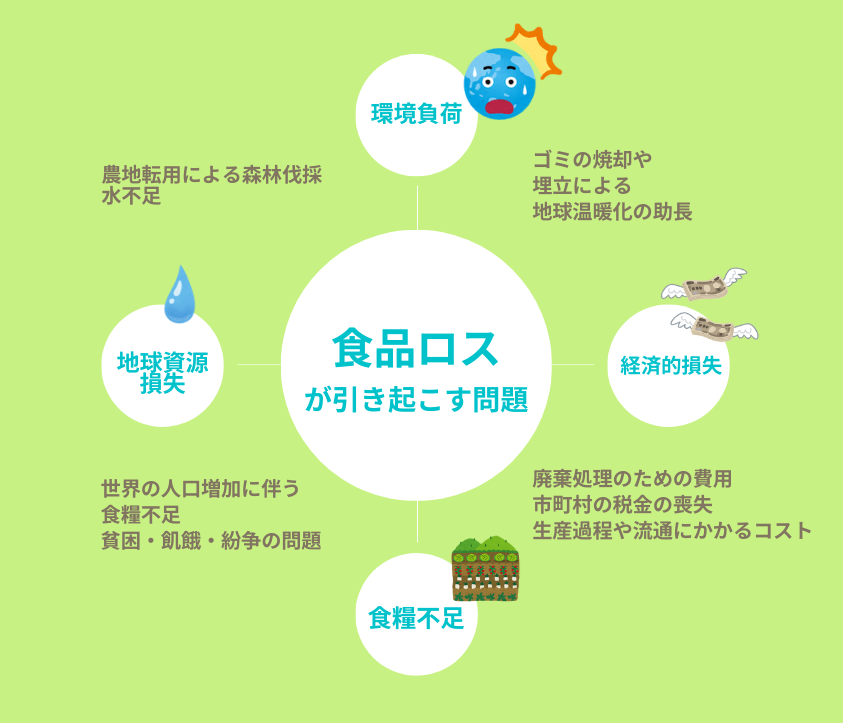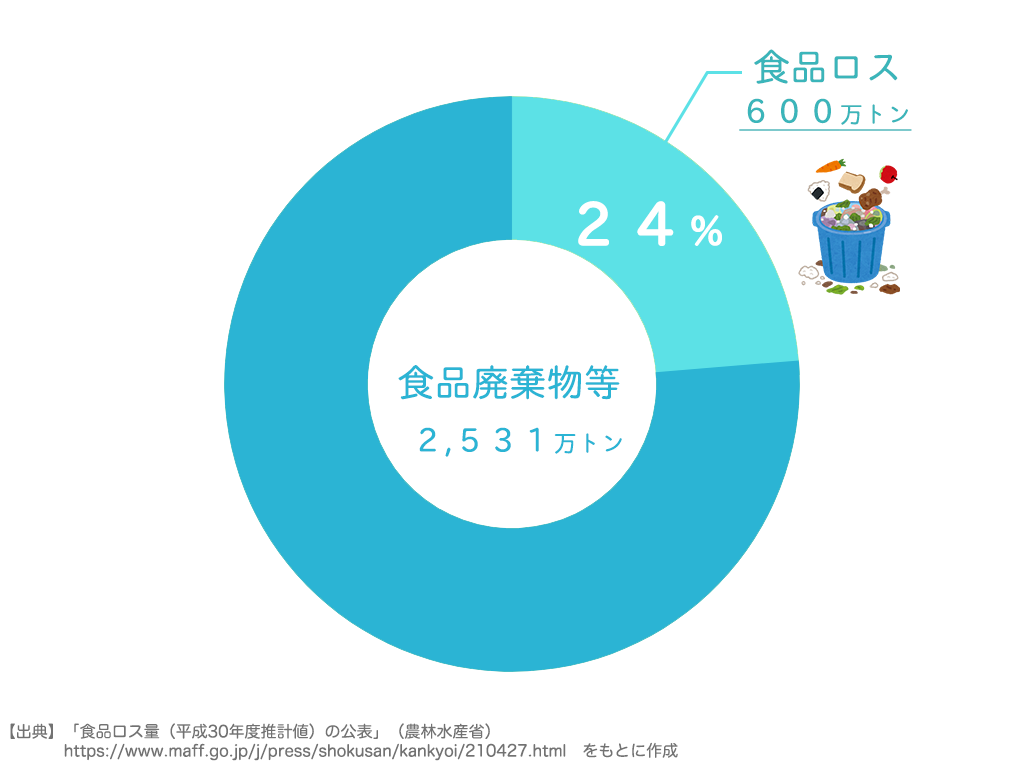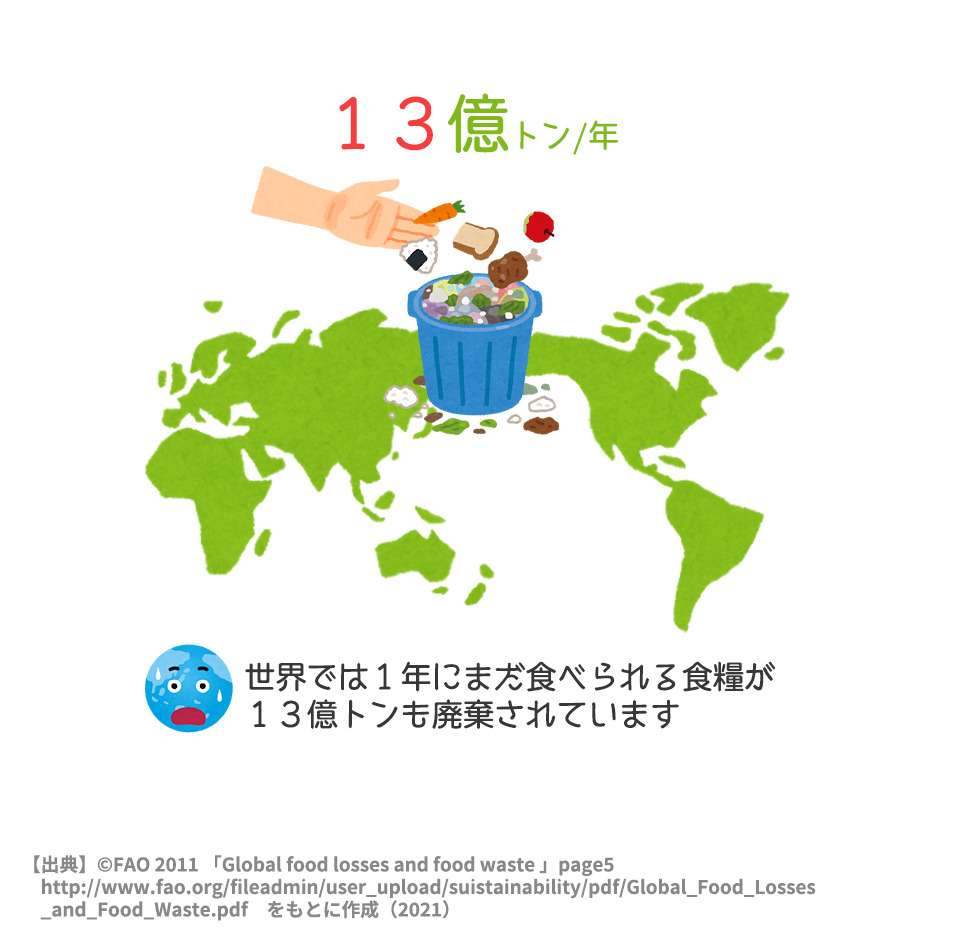Many of you may think that you have been hearing the terms “food loss” and “food loss” a lot lately. Currently, Japan and the rest of the world are facing a variety of problems caused by food loss. There is a growing international movement to reduce food loss.
What is food loss!
What is “food loss” anyway? It refers to food that is thrown away even though it can still be eaten. It does not include originally inedible parts (such as bones and seeds of fish). In Japanese, the term “food loss” or “food loss” is used. In the Food and Agriculture Organization of the United Nations (FAO),
- food loss:
Refers to a decrease in the quantity or quality of food due to decisions and actions by food suppliers in the chain, excluding retailers, foodservice providers, and consumers
- food waste:
Refers to a decrease in the quantity or quality of food due to decisions and actions by retailers, foodservice providers, and consumers
*1*2 [Source] @FAO “Technology Platform for Measuring and Reducing Food Loss and Waste” http://www.fao.org/platform-food-loss-waste/en/
The definition of “food loss” is as follows. In Japan, the term “food loss” is often used, but the English term “food loss” does not include food service providers and consumers, and the meaning of the Japanese term “food loss” is slightly different. Food loss in general is often described as “food loss and waste” in English.
Problems Caused by Food Loss

Food loss is not only the cause of food shortages, but is also connected to all kinds of problems such as environmental issues and loss of global resources. Food loss is not only a problem of one's own country, but also of the entire planet, and efforts to reduce food loss by each individual as a member of the global community will lead to changes in global poverty and environmental problems.
Japan discards 6 million tons per year

According to data released by the Ministry of the Environment and the Ministry of Agriculture, Forestry and Fisheries in April 2021, the amount of food loss generated in Japan in fiscal year 2008 was approximately 25.31 million tons of “food waste,” of which “food loss” was approximately 6 million tons*3. Although the amount has been gradually decreasing over the past few years, this much food loss is still occurring in Japan.
One of the goals of the Sustainable Development Goals (SDGs) is to halve the amount of waste by 2030 compared to the 2000 level, and Japan aims to reduce the amount to 4.89 million tons*4.
*3 [Source] “Publication of the Amount of Food Loss (FY 2008 Estimates)” (Ministry of Agriculture, Forestry and Fisheries) https://www.maff.go.jp/j/press/shokusan/kankyoi/210427.html
*4 [Source] “Reference materials related to food loss reduction” (Consumer Affairs Agency) https://www.caa.go.jp/policies/policy/consumer_policy/information/food_loss/efforts/assets/efforts_ 210309_0001.pdf
Causes of food loss
Food loss is mainly divided into food loss from households and food loss from businesses. Of the 6 million tons of food loss in Japan (in FY 2008)*5, 2.76 million tons are from households and 3.24 million tons*6 are from businesses. Let's take a look at the causes of each.
Causes of household-based food loss
key point
・Leftovers
When cooked food is thrown away due to overcooking or leftovers
・Direct disposal
This is when food is overbought and damaged, expires unnoticed in the refrigerator, or is thrown away without cooking.
・Excessive Removal
Excessive peeling of vegetables and fruits, and removal of edible parts such as stems.
In order to reduce food loss at home, it is possible to reduce food loss through daily awareness such as buying enough food to eat, regularly checking the amount of food in the refrigerator and its expiration date, and freezing leftover food if it can be frozen.
Causes of business-related food loss
key point
・Losses and returns due to misprints and out-of-spec product in the manufacturing process
・Expired products and unsold products from food manufacturers and retailers
・Losses and leftovers from restaurants and other food service establishments
Food loss occurs frequently in the food distribution process, from production to delivery to consumers. There is a growing movement to review business practices, such as reducing overproduction, displaying best-by dates and relaxing delivery deadlines (reviewing the one-third rule).
*5*6 [Source] “Publication of the Amount of Food Loss (FY 2008 Estimate)” (Ministry of Agriculture, Forestry and Fisheries) https://www.maff.go.jp/j/press/shokusan/kankyoi/210427.html
Global Food Loss Problem

What about in the world? According to the Food and Agriculture Organization of the United Nations (FAO), 1.3 billion tons*7 of still edible food is wasted every year. This is equivalent to one-third*8 of the world's food production. This means that one-third of the food we produce is thrown away.

The 10 countries with the highest amount of household food waste per year according to the UNEP Food Waste Index Report 2021 by UNEP are shown in the figure above. Japan ranks fourth in the world with 8.15 million tons. (The figure seems to be different from the data published by the Ministry of the Environment.) The following are the annual household food waste figures and estimated per capita household food waste for the 10 countries listed above.
- China (9,164,213 tons, 64 kg per capita)
- India (6,876,163 tons, 50 kg per capita)
- United States (19,359,951 tons, 59 kg per capita)
- Japan (8,150,9891 tons, 64 kg per capita)
- Germany (6,263,775 tons, 75 kg per capita)
- France (5,522,358 tons, 85 kg per capita)
- United Kingdom (5,199,825 tons, 77 kg per capita)
- Russia (4,868,564 tons, 33 kg per capita)
- Spain (3,613,954 tons, 77 kg per capita)
- Australia (2,563,110 tons, 102 kg per capita)
[Source: UNEP Food Waste Index Report 2021United Nations Environment Programme (2021). Based on Food Waste Index Report 2021. Nairobi. https://www.unep.org/resources/report/unep-food-waste-index-report-2021]
Food loss can be divided into household and business-related losses, but household food loss also accounts for a large portion of food loss. In Japan, households account for about half of food loss, although it is less than that of businesses. It is important to reduce food loss by taking care not to overbuy food at home and by making creative adjustments to daily meals.
*7*8 [Source] © FAO 2011 “Global Food Loss and Food Waste” page5 http://www.fao.org/fileadmin/user_upload/suistainability/pdf/Global_Food_Losses_and_Food_Waste. pdf

